
How Employers Can Prevent Construction Site Accidents and Injuries

How Employers Can Prevent Construction Site Accidents and Injuries
Working in the construction industry is, without a doubt, a dangerous occupation. There is a considerable risk of injury from a construction accident, given the nature of the activities and numerous safety hazards at construction sites.

How to prevent construction accidents?
Receive a Free Consultation Today!
This is why employers need to work towards mitigating these risks. The Occupational Safety and Health Administration (OSHA) requires companies to create a safe working environment. Owners must adopt certain protocols to protect construction workers and reduce construction accidents annually. In this article, we will provide you with a few tips to help create a safer work environment for your employees and reduce the number of incidents on your watch.
The Statistics
According to the National Center for Biotechnology Information (NCBI), accident rates in construction companies are 71% greater than that of all other industries combined.
Furthermore, according to the Bureau of Labor Statistics, 1.7 percent of construction workers in the United States experience a serious accident that requires them to leave work every year.
That’s why it’s so important for employers in the construction industry to understand the dangers their employee’s face and learn how they can create a safer work environment. You can build a safer workplace culture by identifying potential warning signs and taking the appropriate safety precautions.
The Most Common Construction Site Injuries
The truth is that a lot is going on at construction sites. There are moving parts, falling debris, and electrical equipment, and workers are often required to work at heights, so it’s no surprise that construction site accidents happen so frequently.
Many of these hazards can cause serious injuries and even death, so following the correct protection protocols is essential to ensure that your construction sites are safe.
Here are some of the most common construction injuries that occur at these sites:
- Spinal injuries
- Brain injuries
- Broken bones
- Burns
- Exposure to chemicals
- Blindness and vision impairment.
The Fatal Four: Top Causes of Accidents at Construction Sites
Identifying the most common causes of construction accidents can help you identify occupational safety hazards. Once you understand the safety hazards, you can provide the appropriate safety training and personal protective equipment (PPE) to keep workers safe at a job site.
Accidents that occur most frequently among construction workers are:
- Slips, trips, and falls
- Falling objects
- Electrocution
- Being crushed by heavy machinery.
These construction accidents, often referred to as the “fatal four,” accounted for more than 50 percent of all construction fatalities in 2017, so you must understand these hazards.
1. Slips, Trips, and Falls
Slips, trips, and falls accounted for over 39 percent of construction-related deaths in 2017, so it is essential that employers take the appropriate precautions to help prevent injuries.
OSHA Recommendations
According to the Occupational Safety and Health Administration (OSHA), employers are required to do the following to protect workers from slip, trip, and fall accidents:
- Use a cover or railing and toe-board to protect any floor holes that workers might fall into
- Maintain a safe working environment by ensuring that floors are clean and dry
- Include a toe-board and guardrail for all elevated one-sided platforms
- Supply construction workers with free PPE or safety gear to prevent falls, including stair railings, safety harnesses, handrails, and safety nets
- Suppose workers are in danger of falling onto hazardous equipment or machinery. In that case, employers are required to provide a toe-board and guardrail
2. Falling Objects
Many construction site accidents occur because a construction worker is struck by an object that falls from a height. It’s important to remember that the higher the object is before it falls, the greater its velocity when it reaches the ground.
Falling Objects Have a Greater Impact Than You Might Think
A tool weighing just eight pounds that falls from a height of approximately 200 feet will fall at about 80 miles per hour. If that object were to strike a worker below, it could cause serious injuries.
Ensuring That Your Workers Are Safe
Workers must be encouraged to maintain a safe distance from suspended loads and moving parts to prevent construction accidents caused by falling objects or moving objects nearby.
OSHA Recommendations
According to OSHA standards, employers must:
- Ensure that construction workers have the appropriate PPE, such as high visibility reflector vest, eye and facial protection, and hard hats
- Before using lifting or dumping equipment, employers must ensure that workers are kept away from the site
- Ensure that construction vehicles are not operated in reverse with their rearview obscured
- When work is taking place near roads, barricades, traffic signs, or flaggers must be used.
3. Electrocutions
Although not as common as other types of construction accidents, electrocution also poses a threat to construction workers. Because there’s often lots of machinery and electrical equipment in use, exposed wires, contact with power lines, and more can cause a construction worker to be electrocuted.
OSHA Recommendations
To prevent electrocutions, the OSHA requires employers to protect workers by enforcing the following safety protocols:
- Ensure that workers have the appropriate PPE to reduce the electrocution. This includes eye and facial protection, gloves, and non-conductive boots.
- When personnel is close by, make sure that any circuitry is either grounded, de-energized, or appropriately protected by insulation.
- Supply electrical tools like grounded hand tools approved by a certified testing center.
4. Being Crushed by Heavy Machinery
The truth is that heavy machinery increases the risk of a construction site accident. When construction employees are caught in or crushed by dangerous machinery, the results can be fatal.
Accidents involving falling structures, machinery, or supplies can also crush workers. Those are working on excavation operations, whose fatality rates are 112 percent greater than in building constructions, are at greater risk of falling prey to these accidents.
OSHA Recommendations
To prevent construction accidents where workers are crushed, employers need to take note of the following OSHA standards:
- Machinery and heavy equipment must be appropriately guarded
- Take precautions to guarantee that heavy machinery that may tip does not endanger employees
- Employees must maintain a safe distance from heavy machinery and avoid putting themselves between moving objects or materials.
- Take care to guarantee that employees are not crushed during the demolition process.
- Ensure that workers wear their seatbelts and that any items being moved are securely fastened and braced.
- To avoid scaffolding collapsing, make sure it’s built by someone who knows what they’re doing.
- Excavations that are deeper than five feet should be safeguarded by using adequate sloping or benching techniques, shoring, and shields or trench boxes.
- There must also be adequate access and departure routes within the trench’s protected region, such as ramps, stairways, and ladders.
How Employers Can Prevent Construction Site Accidents
Here are some important tips to help you keep your job site safe and prevent construction accidents.
1. Provide Adequate Training
The truth is that inadequate training can cause a construction site accident if workers don’t know how to properly operate tools and work safely. The first step towards ensuring occupational safety at construction sites is by providing training and refresher courses.
Training materials must be supplied in a language that every construction worker understands so that everyone learns how to spot hazards and operate equipment correctly. You may be required to produce training materials in multiple languages or employ multilingual trainers.
2. Focus on Signage
You can help prevent construction accidents on a job site by including clearly visible safety signage. Make sure that any sites with inherent risks, such as falling debris, are cordoned off.
Any high-voltage or hazardous places where workers may be at risk of chemical exposure should be made known to both workers and passers-by.
3. Ensure That the Appropriate PPE Is Worn at All Times
PPE is a worker’s first line of defense and works to keep employees safe while at a construction site. The employer must provide workers with the PPE they need.
Examples of PPE that construction workers may need to include:
- Gloves
- A hard hat or helmet
- Safety glasses or goggles
- Steel-toed safety boots
- Earplugs.
4. Maintain Equipment Properly
Faulty equipment can also put workers in danger, so all equipment and machinery must be properly maintained. You will likely need to contact the manufacturer or a service provider to ensure that all your equipment meets the relevant safety standards.
5. Have Regular Safety Meetings with Your Construction Workers
Regular safety meetings can help create a safety culture at construction sites. You can keep safety procedures fresh in your workers’ minds by organizing these meetings regularly. All employees must clearly grasp the company’s safety procedures and why they are necessary when working at a construction site.
6. Conduct Routine Safety Inspections
Project supervisors and team leaders should conduct daily safety checks to detect and remove potential hazards. You can share your learnings with the rest of the team to prevent any unsafe behavior from being repeated.
7. Provide Fall Protection
As we’ve already seen, falling from a height poses a considerable risk to workers at a job site. Therefore, employers must provide fall protection. Falls can be extremely dangerous and have already claimed the lives of thousands of construction workers. Ensure that all floor gaps are covered to prevent accidents and provide temporary guardrails if necessary. You may also need to provide harnesses and lines.
8. Make Sure that Your Construction Site Has Adequate Storage Solutions
Every day, workers are exposed to hazardous and harmful substances, which is why it’s critical to implement proper material storage systems. This will prevent objects from falling, which can lead to an accident.
9. Ensure That Workers Can Easily Report Issues
Employers are also required to keep track of occupational injuries and accidents, and construction workers should have access to this information to learn about potentially hazardous equipment or locations on the job site.
It should also be easy for employees to report any risks. Employers must take these problems seriously and address them with a risk assessment as soon as possible. They must guarantee the safety of their employees with steel-toed boots, hard hats, and other safety gear. This is a huge way to avoid workplace fatalities and most injuries.
Need a Construction Accident Lawyer? Contact Ehline Law Firm Today!
If you or someone you love has been involved in a construction site accident resulting from an employer’s negligence, get in touch with us to find out how you can obtain compensation for your losses. Ehline Law Firm has a team of award-winning attorneys with decades of experience with construction accident cases. Contact us today to book a free consultation and case review!
Categories

Michael Ehline
Michael Ehline is an inactive U.S. Marine and world famous legal historian. Michael helped draft the Cruise Ship Safety Act and has won some of the largest motorcycle accident settlements in U.S. History. Together with his legal team, Michael and the Ehline Law Firm collect damages on behalf of clients. We pride ourselves in being available to answer your most pressing and difficult questions 24/7. We are proud sponsors of the Paul Ehline Memorial Motorcycle Ride, and a Service Disabled Veteran Operated Business. (SDVOB.) We are ready to fight.
Go here for More Verdicts and Settlements
